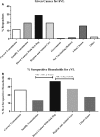Preventing zoonotic canine leishmaniasis in northeastern Brazil: pet attachment and adoption of community Leishmania prevention
- PMID: 22987654
- PMCID: PMC3516256
- DOI: 10.4269/ajtmh.2012.12-0251
Preventing zoonotic canine leishmaniasis in northeastern Brazil: pet attachment and adoption of community Leishmania prevention
Abstract
Visceral leishmaniasis (VL), caused by Leishmania infantum chagasi (L.i. chagasi syn. infantum) in northeastern Brazil, was responsible for 51,000 new VL cases from 1980 to 2003. Household presence of L. infantum-infected dogs is a major risk factor for human infection. Despite culling of dogs based on seropositivity, canine L. infantum seroprevalence remains near 20%, suggesting that dog culling is ineffective for preventing VL spread. We administered a cross-sectional survey to 224 households within 300 m of the homes of VL human patients diagnosed within the last year. The goal was to develop a model for voluntary preventative use based on characteristics and motivations of dog owners. We identified that owner knowledge deficiencies regarding canine transmission of L. infantum associated with increased risk of dog infection (odds ratio [OR] = 3.681, confidence interval [CI] = 1.223, 11.08). Higher owner education was associated with decreased levels of dog seropositivity (OR = 0.40, CI = 0.20, 0.81). Pet attachment (P = 0.036) and perception of risk/disease knowledge (P = 0.040) were significantly associated with willingness to voluntarily purchase canine VL prevention. These results highlight the importance of owner attachment to their pet in implementing reservoir-targeted zoonotic VL prevention.
Figures



Similar articles
-
Prevalence and factors associated with Leishmania infantum infection of dogs from an urban area of Brazil as identified by molecular methods.PLoS Negl Trop Dis. 2011 Aug;5(8):e1291. doi: 10.1371/journal.pntd.0001291. Epub 2011 Aug 16. PLoS Negl Trop Dis. 2011. PMID: 21858243 Free PMC article.
-
[Epidemiology of Leishmania (L.) infantum, L. major and L. killicki in Tunisia: results and analysis of the identification of 226 human and canine isolates].Bull Soc Pathol Exot. 2008 Oct;101(4):323-8. doi: 10.3185/pathexo3201. Bull Soc Pathol Exot. 2008. PMID: 18956815 French.
-
Spatial distribution of canine Leishmania infantum infection in a municipality with endemic human leishmaniasis in Eastern Bahia, Brazil.Rev Bras Parasitol Vet. 2021 May 28;30(2):e022620. doi: 10.1590/S1984-29612021034. eCollection 2021. Rev Bras Parasitol Vet. 2021. PMID: 34076050
-
Canine Leishmaniasis Control in the Context of One Health.Emerg Infect Dis. 2019 Dec;25(12):1-4. doi: 10.3201/eid2512.190164. Emerg Infect Dis. 2019. PMID: 31742505 Free PMC article.
-
Current status and management of canine leishmaniasis in Latin America.Res Vet Sci. 2019 Apr;123:261-272. doi: 10.1016/j.rvsc.2019.01.022. Epub 2019 Jan 23. Res Vet Sci. 2019. PMID: 30708238 Review.
Cited by
-
Transmission and epidemiology of zoonotic protozoal diseases of companion animals.Clin Microbiol Rev. 2013 Jan;26(1):58-85. doi: 10.1128/CMR.00067-12. Clin Microbiol Rev. 2013. PMID: 23297259 Free PMC article. Review.
-
Immunologic progression of canine leishmaniosis following vertical transmission in United States dogs.Vet Immunol Immunopathol. 2016 Jan;169:34-8. doi: 10.1016/j.vetimm.2015.11.008. Epub 2015 Dec 2. Vet Immunol Immunopathol. 2016. PMID: 26827836 Free PMC article.
-
Understanding the risk perception of visceral leishmaniasis exposure and the acceptability of sandfly protection measures among migrant workers in the lowlands of Northwest Ethiopia: a health belief model perspective.BMC Public Health. 2022 May 16;22(1):989. doi: 10.1186/s12889-022-13406-3. BMC Public Health. 2022. PMID: 35578331 Free PMC article.
-
Prevalence and incidence of vector-borne pathogens in unprotected dogs in two Brazilian regions.Parasit Vectors. 2020 Apr 21;13(1):195. doi: 10.1186/s13071-020-04056-8. Parasit Vectors. 2020. PMID: 32312297 Free PMC article.
-
Impact of Education on Knowledge and Practice of Kala Azar Preventive Measures among Seasonal and Migrant Agricultural Workers in Northwest Ethiopia.Am J Trop Med Hyg. 2020 Apr;102(4):758-767. doi: 10.4269/ajtmh.19-0079. Am J Trop Med Hyg. 2020. PMID: 32043439 Free PMC article.
References
-
- Werneck GL. Forum: geographic spread and urbanization of visceral leishmaniasis in Brazil. Introduction. Cad Saude Publica. 2008;24:2937–2940. - PubMed
-
- Barreto ML, Teixeira MG, Bastos FI, Ximenes RA, Barata RB, Rodrigues LC. Successes and failures in the control of infectious diseases in Brazil: social and environmental context, policies, interventions, and research needs. Lancet. 2011;377:1877–1889. - PubMed
-
- Tasca KI, Buzetti WA, Tenorio Mda S, Paulan Sde C, Lima FL, de Queiroz NM, Machado RZ, Oliveira TM, Neves MF, de Noronha AC, Jr, de Assis J. Parasitological, immunohistochemical and histopathological study for Leishmania chagasi detection in splenic tissues of dogs with visceral leishmaniasis. Rev Bras Parasitol Vet. 2009;18:27–33. - PubMed
-
- Queiroz PV, Monteiro GR, Macedo VP, Rocha MA, Batista LM, Queiroz JW, Jeronimo SM, Ximenes MF. Canine visceral leishmaniasis in urban and rural areas of northeast Brazil. Res Vet Sci. 2009;86:267–273. - PubMed
Publication types
MeSH terms
Grants and funding
LinkOut - more resources
Full Text Sources
Medical
Miscellaneous

